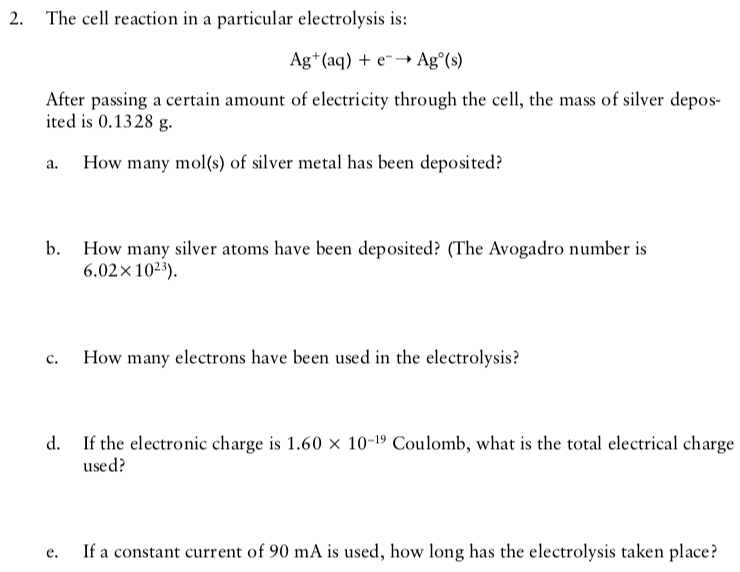The cell reaction in a particular electrolysis is: Ag*(aq) + e-→ Ag°(s) After passing a certain amount of electricity through the cell, the mass of silver depos- ited is 0.13 28 g. How many mol(s) of silver metal has been deposited? a. How many silver atoms have been deposited? (The Avogadro number is 6.02×1023). с. How many electrons have been used in the electrolysis? If the electronic charge is 1.60 x 10-19 Coulomb, what is the total electrical charge used? If a constant current of 90 mA is used, how long has the electrolysis taken place? е.
The cell reaction in a particular electrolysis is: Ag*(aq) + e-→ Ag°(s) After passing a certain amount of electricity through the cell, the mass of silver depos- ited is 0.13 28 g. How many mol(s) of silver metal has been deposited? a. How many silver atoms have been deposited? (The Avogadro number is 6.02×1023). с. How many electrons have been used in the electrolysis? If the electronic charge is 1.60 x 10-19 Coulomb, what is the total electrical charge used? If a constant current of 90 mA is used, how long has the electrolysis taken place? е.
Chemistry: Principles and Practice
3rd Edition
ISBN:9780534420123
Author:Daniel L. Reger, Scott R. Goode, David W. Ball, Edward Mercer
Publisher:Daniel L. Reger, Scott R. Goode, David W. Ball, Edward Mercer
Chapter18: Electrochemistry
Section: Chapter Questions
Problem 18.78QE
Related questions
Question
need help with parts d. & e. please

Transcribed Image Text:2. The cell reaction in a particular electrolysis is:
Ag*(aq) + e-→ Ag°(s)
After passing a certain amount of electricity through the cell, the mass of silver depos-
ited is 0.1328 g.
How many mol(s) of silver metal has been deposited?
b. How many silver atoms have been deposited? (The Avogadro number is
6.02x1023).
How many electrons have been used in the electrolysis?
с.
d. If the electronic charge is 1.60 x 10-19 Coulomb, what is the total electrical charge
used?
If a constant current of 90 mA is used, how long has the electrolysis taken place?
е.
Expert Solution
This question has been solved!
Explore an expertly crafted, step-by-step solution for a thorough understanding of key concepts.
This is a popular solution!
Trending now
This is a popular solution!
Step by step
Solved in 3 steps

Knowledge Booster
Learn more about
Need a deep-dive on the concept behind this application? Look no further. Learn more about this topic, chemistry and related others by exploring similar questions and additional content below.Recommended textbooks for you

Chemistry: Principles and Practice
Chemistry
ISBN:
9780534420123
Author:
Daniel L. Reger, Scott R. Goode, David W. Ball, Edward Mercer
Publisher:
Cengage Learning

Chemistry: Principles and Reactions
Chemistry
ISBN:
9781305079373
Author:
William L. Masterton, Cecile N. Hurley
Publisher:
Cengage Learning

General Chemistry - Standalone book (MindTap Cour…
Chemistry
ISBN:
9781305580343
Author:
Steven D. Gammon, Ebbing, Darrell Ebbing, Steven D., Darrell; Gammon, Darrell Ebbing; Steven D. Gammon, Darrell D.; Gammon, Ebbing; Steven D. Gammon; Darrell
Publisher:
Cengage Learning

Chemistry: Principles and Practice
Chemistry
ISBN:
9780534420123
Author:
Daniel L. Reger, Scott R. Goode, David W. Ball, Edward Mercer
Publisher:
Cengage Learning

Chemistry: Principles and Reactions
Chemistry
ISBN:
9781305079373
Author:
William L. Masterton, Cecile N. Hurley
Publisher:
Cengage Learning

General Chemistry - Standalone book (MindTap Cour…
Chemistry
ISBN:
9781305580343
Author:
Steven D. Gammon, Ebbing, Darrell Ebbing, Steven D., Darrell; Gammon, Darrell Ebbing; Steven D. Gammon, Darrell D.; Gammon, Ebbing; Steven D. Gammon; Darrell
Publisher:
Cengage Learning


Chemistry: An Atoms First Approach
Chemistry
ISBN:
9781305079243
Author:
Steven S. Zumdahl, Susan A. Zumdahl
Publisher:
Cengage Learning

Chemistry
Chemistry
ISBN:
9781305957404
Author:
Steven S. Zumdahl, Susan A. Zumdahl, Donald J. DeCoste
Publisher:
Cengage Learning